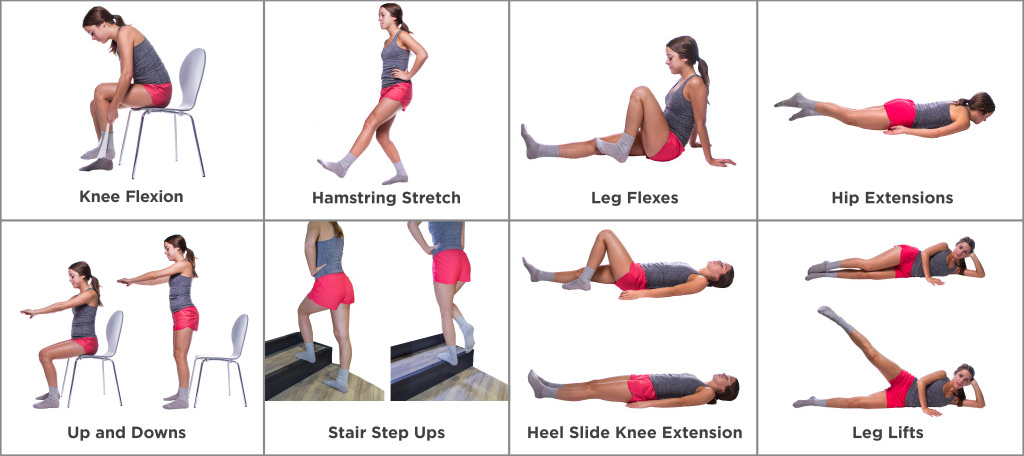
How exercise helps knee arthritis
Arthritis affects millions of people around the world. Two of the most common types are osteoarthritis (OA) and rheumatoid arthritis (RA). Both types often lead to knee pain.
Exercising an arthritic knee may seem counterintuitive, but regular exercise can actually lessen — and even relieve — arthritis pain and other symptoms, such as stiffness and swelling.
There are several reasons to exercise with knee arthritis:
- Exercise maintains the joint’s full range of motion.
- Exercise strengthens the muscles that support the joint.
- Strong muscles help the joint absorb shock.
Exercise doesn’t have to be hard to be beneficial. In fact, gentle, low-impact exercises are best for knee arthritis. They minimize stress on the joint as they increase their flexibility and strength.
Exercising at home or work
The best knee exercises may be the ones you can do at home or even during a break at the office. They’re easy, effective, and convenient, and don’t require any special equipment. Do them slowly and gradually increase the number of repetitions, as your muscles get stronger.
Afterward, be sure to do a few gentle stretching exercises to help prevent your muscles from tightening up. Consider exercising your knees every other day to give sore muscles a rest.
Leg raise (lying)
- Lie flat on your back on the floor or bed with your arms at your sides, toes up.
- Keep your leg straight while tightening your leg muscles, and slowly lift it several inches.
- Tighten your stomach muscles to push your lower back down.
- Hold and count to 5, then lower your leg as slowly as possible.
- Repeat, and then switch to the other leg.
Exercise tip: Start with one set of four for each leg.
Why it works: This exercise strengthens the quadriceps, which are the large muscles on the fronts of your thighs that attach to your knee joints.
Hamstring stretch (lying)
- Lie on the floor or bed with both legs bent.
- Slowly lift one leg, still bent, and bring your knee back toward your chest.
- Link your hands behind your thigh, not your knee, and straighten your leg.
- Pull your straight leg back toward your head until you feel the stretch.
- Hold for 30 to 60 seconds, then slowly bend your knee and lower your leg back to the floor.
Exercise tip: Perform the stretch 1 time on each leg.
Why it works: This exercise stretches and strengthens your hamstrings, which are the muscles on the backs of the thighs that attach to the knees.
Half-squat
- Stand with your feet shoulder-distance apart and stretch your arms out in front of you.
- Slowly bend your knees until you’re in a half-sitting position. Hold on to a chair for balance, if necessary.
- Keep your back straight and chest lifted — don’t lean forward.
- With your feet flat on the floor, hold the position for 5 seconds, and then slowly stand back up.
There should be no pain while performing this exercise.
Exercise tip: Do 10 repetitions, and slowly work up to three sets of 10.
Why it works: This exercise strengthens the muscles on the fronts and backs of your thighs, along with the gluteus.
One-leg dip
- Stand between two chairs and hold on to them for balance.
- Lift one leg about 12 inches and hold it out in front of you.
- Slowly, keeping your back straight, bend the other leg and lower your body a few inches, as if you were about to sit in a chair. Don’t cross the lifted leg in front of the bent leg.
- Hold for 5 seconds and straighten back up.
- Repeat and switch legs.
Exercise tip: Start with one set of four leg dips for both legs, and slowly work up to three sets.
Why it works: This exercise strengthens the muscles on the fronts and backs of your thighs, as well as your buttocks.
Leg stretch
- Sit on the floor with both legs out straight. Stabilize yourself with your hands on either side of your hips, and keep your back straight.
- Slowly bend one knee until it feels stretched, but not until it becomes painful.
- Hold your leg in that position for 5 seconds, and then slowly straighten your leg out as far as you can, again holding for 5 seconds.
Exercise tip: Repeat and switch legs whenever one begins to tire, 10 times.
Why it works: This exercise also strengthens the quadriceps.
Precision Pain Care and Rehabilitation has two convenient locations in the Richmond Hill – Queens and New Hyde Park – Long Island. Call the Richmond Hill office at (718) 215-1888, or (516) 419-4480 for Long Island office, to arrange an appointment with our Interventional Pain Management Specialist, Dr. Jeffrey Chacko.













